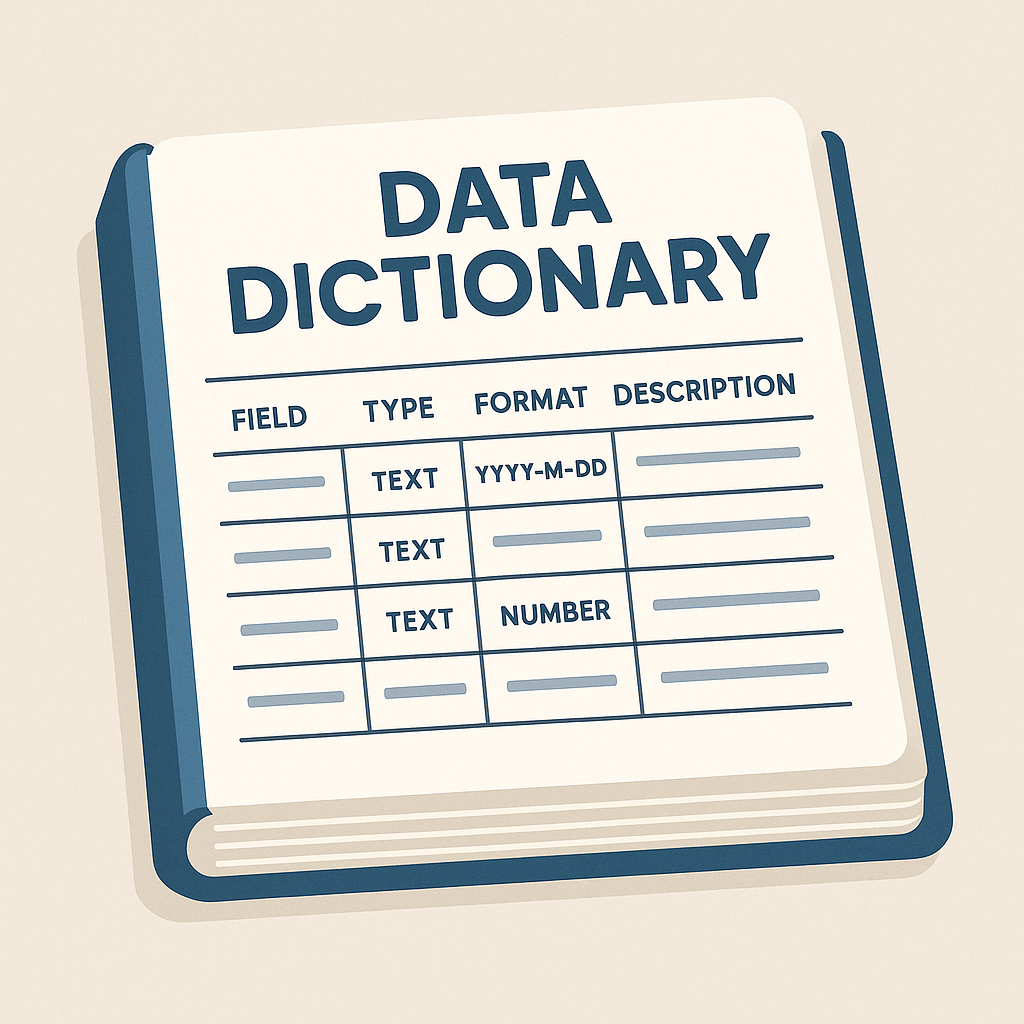First in the “Tools for Data Governance” series.
When people talk about “data governance tools,” they often jump straight to data catalogues or enterprise-wide platforms. But before those came along, there was the humble data dictionary, the quiet workhorse that keeps organisations speaking the same data language.
What Is a Data Dictionary?
A data dictionary is a central repository that describes and defines data in a consistent way. It lists the elements that make up a dataset: tables, fields, metrics, along with what they mean, what values they can take, and how they relate to each other.
Think of it as the single source of truth for what data means within your organisation. Whether you’re a database administrator, a data analyst, or a business manager, a well-maintained data dictionary ensures you’re all interpreting data in the same way.
Beyond definitions, data dictionaries often include technical details such as data types, formats, and constraints. This combination of business meaning and technical metadata helps maintain data integrity, improves communication, and reduces errors in analysis and reporting.
However, not all data dictionaries serve the same purpose. To understand how they fit within the broader data governance landscape, it’s important to distinguish between operational-level and enterprise-level approaches.
Operational vs Enterprise-Level Data Dictionaries
The Operational Data Dictionary
An operational data dictionary focuses on a specific system or application. It’s highly detailed and technical, the kind of documentation that lists every field in a student information system, its data type, and what it’s used for.
For example, it might define:
Student_IDas an integer key in the Students tableEnrollment_Statusas a field that can be “Full-time” or “Part-time”
This kind of dictionary is typically maintained by IT or database teams and used by developers or data engineers. It’s invaluable for anyone working directly with the data, but it’s not designed for business users.
In higher education, this might mean that while an analyst knows exactly what’s in the “Student” table, they still might not know which system’s version of “Student” is the official source, or how metrics like “continuation rate” are actually calculated.
As data governance expert Aaron Walker puts it, operational data dictionaries are rich in technical detail but can be isolated in scope. On their own, they face a few key limitations:
- Isolated View: They describe data within one system but don’t show how it connects to others.
- Derived Metrics: They don’t always explain how calculated or composite measures are created.
- Accessibility: They can be too technical or cumbersome for non-specialists to navigate.
In short, operational dictionaries offer depth, but not reach.

The Enterprise Data Catalog
That’s where enterprise-level data governance tools come in, such as data catalogues, business glossaries, and governance suites.
Whereas an operational dictionary is like a detailed catalogue for one library, an enterprise data catalogue is more like a city-wide library map, showing how every collection connects and how to find what you need.
These tools bring together metadata from across an organisation’s systems, adding layers of business meaning, searchability, and governance. A good data catalog might show:
- The definition of “Student” from the business glossary
- The related technical fields in different databases
- Who owns or stewards that data
- How the data flows through different systems (lineage)
They also provide governance features, such as workflows for approving definitions, assigning data owners, and enforcing data quality or compliance rules. This makes them useful not only to technical teams but also to analysts, managers, and data stewards.
In short:
| Feature | Operational Data Dictionary | Enterprise Data Catalog |
|---|---|---|
| Scope | One system or domain | Multiple systems across the organisation |
| Audience | Technical users | Technical and business users |
| Content | Technical metadata (tables, fields, types) | Technical + business metadata, data lineage, stewardship info |
| Governance | Limited or manual | Built-in workflows and governance structures |
Working Together, Not Apart
The best data governance programmes use both levels in tandem. Operational data dictionaries provide the precise, field-level information needed for accuracy at the source. Enterprise data catalogues then aggregate and contextualise that information, giving everyone a shared, organisation-wide understanding of what data means.
In higher education, for instance:
- The operational dictionary might describe every field in the student records system.
- The enterprise catalog might define what “first-time full-time student” means across the university and show how it’s calculated from those fields.
This layered approach allows institutions to maintain both technical precision and business clarity, vital for data-driven decision making and regulatory reporting alike.
As one commentator neatly summed it up:
“A data dictionary brings accuracy at the source; a data catalog brings visibility across the landscape.”